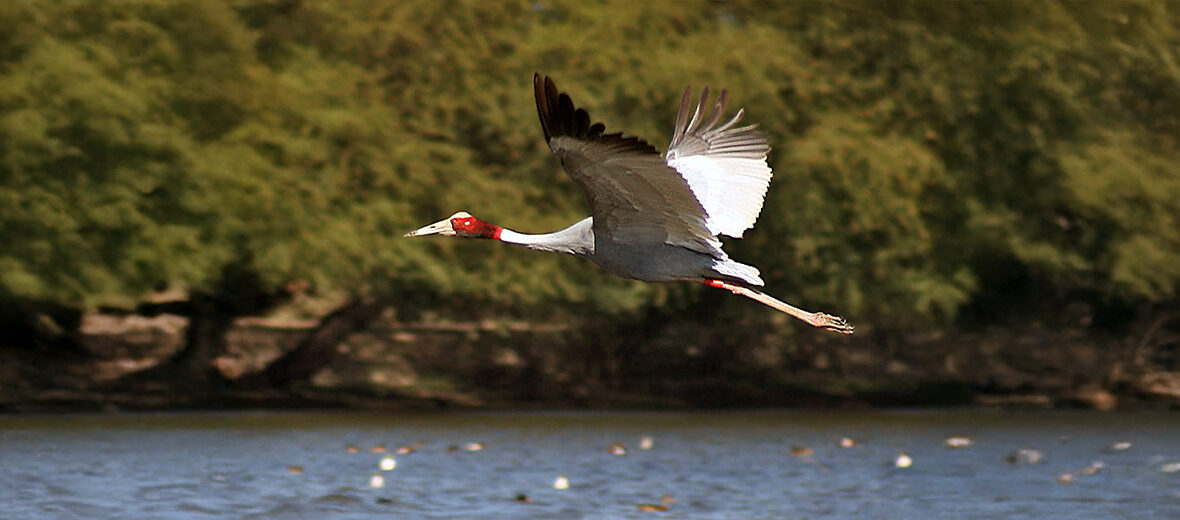
The sarus crane is the tallest flying bird in the world. They can be found among agricultural wetlands, grasslands, and open plains of the Indian subcontinent, Southeast Asia, and northern Australia. These cranes face numerous threats to their survival, including habitat loss and destruction at the hands of residential and commercial developments, farming, ranching, and ecosystem modifications, that drain the wetlands to make way for industry; roads and railroads, that divide their territory and can result in vehicle strike (being hit by vehicles); hunting; trapping; recreational activities, that interfere with their breeding; invasive species, which result in disease and predation; land pollution; water pollution; and climate change, which causes habitat shifting and alteration. The IUCN lists these birds as Vulnerable. Their populations are also decreasing.
First the Stats…
Scientific name: Antigone antigone
Weight: Up to 26 lbs.
Length: Up to 5.11 feet
Wingspan: Up to 8.17 feet
Lifespan: Up to 42 years
Now on to the Facts!
1.) There are only an estimated 15,000+/- wild individuals remaining, to date.
2.) These cranes were first described by English naturalist George Edwards who included an illustration and a description in the first volume of his A Natural History of Uncommon Birds in 1743.
3.) Later in 1758, Swedish naturalist Carl Linnaeus updated his Systema Naturae for the tenth edition, he placed the sarus crane with the herons and cranes in the genus Ardea.
4.) Analysis of mitochondrial DNA suggest that these birds colonized Australia in the Late Pleistocene, approximately 35,000 years ago.
5.) Northern populations tend to grow larger than southern populations.
But wait, there’s more on the sarus crane!
6.) Even though these cranes are mostly sedentary, some populations do partake in short range migrations, if the weather dips below an acceptable range.
7.) These cranes are monogamous (mate for life).
Did you know…?
It is not uncommon for these birds to pine the loss of a mate. So much to the point of starving themselves to death in a fit of depression.
8.) During the mating season they perform territorial and courtship displays which include loud trumpeting, leaps, and dance-like movements & gestures.
9.) Huge nests are constructed of reeds and grasses that can measure up to 6.56 feet across.
10.) Females lay up to 3 eggs that hatch in up to 35 days.
But wait, there’s still more on the sarus crane!
11.) Breeding territories are defended from other cranes using a large variety of calls and visual displays.
12.) Breeding pairs in Australia also defend their territories from neighboring crane pairs, and non-breeding birds are found in flocks often times mixed with brolgas.
Did you know…?
Not really having a breeding season, these birds can breed throughout the year.
13.) The largest known flocks are from the Keoladeo National Park, in India, and can contain as many as 430 birds.
14.) They probe the mud with their long bills in search of insects, fish, frogs, crustaceans, water snakes, aquatic plants, and seeds. In rare cases, they may also be seen feeding on the eggs of other birds.
15.) Even more rare are cases where the chicks of other water birds are taken as prey.
But wait, there’s still a little more on the sarus crane!
16.) Adults have no natural predators. However, eggs are often destroyed at the nest by crows.
17.) Juveniles are preyed on by foxes and dingoes in Australia.
Did you know…?
These birds are venerated in India, and legend has it that the poet Valmiki cursed a hunter for killing a sarus crane and was then inspired to write the epic Ramayana.
18.) Sarus cranes are considered sacred, and these birds are traditionally unharmed. In many areas, they are even unafraid of humans.
19.) Payment to locals to guard their nests and help increase breeding success has been attempted in northern Cambodia, with some success.
20.) The Indian state of Uttar Pradesh declared these cranes as its official state bird in 2013.
Now a Short Sarus Crane Video!
Be sure to share & comment below! Also, check out the Critter Science YouTube channel. Videos added regularly!

Want to suggest a critter for me to write about? Let me know here.
Some source material acquired from: Wikipedia & IUCN
Photo credit: J.M.Garg



